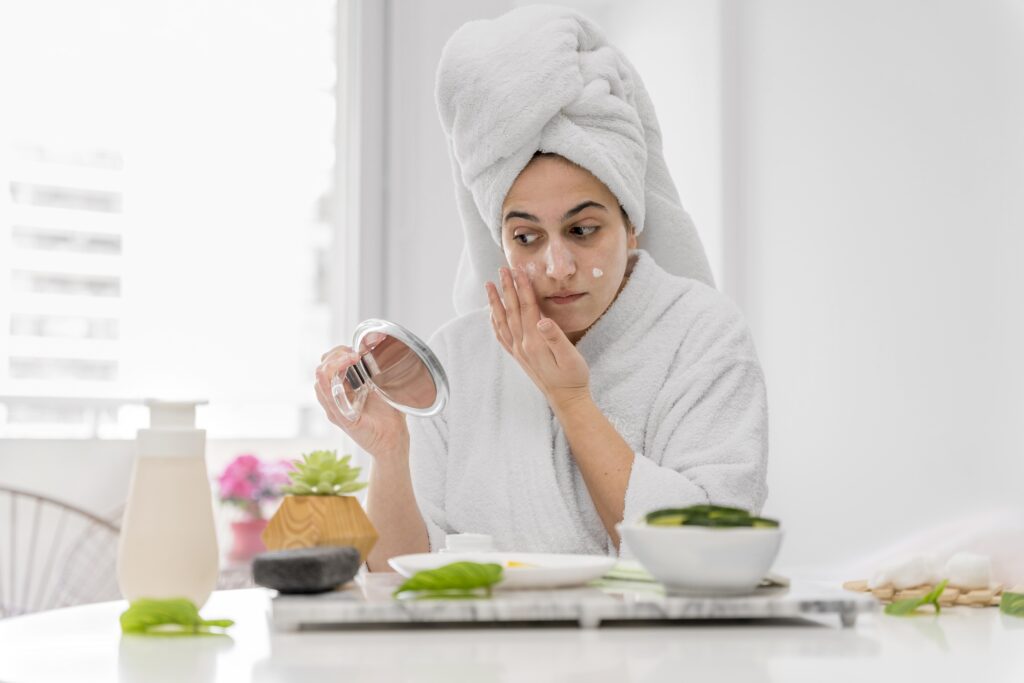Taking care of your skin involves understanding the unique needs of your skin at different times of the day. Morning and night skincare routines serve different purposes and can significantly impact your skin’s health and appearance. Let’s delve into the differences between these two routines.
Morning Skincare Routine
The primary goal of a morning skincare routine is to prepare and protect your skin for the day ahead. Here’s what a typical morning routine might include:
- Cleansing: Start with a gentle cleanser to remove any oil, sweat, or residue from your night time skincare products. This prepares your skin to absorb the next steps.
- Toning: A toner can help balance your skin’s pH and remove any leftover impurities from cleansing. It also prepares your skin for better absorption of other products.
- Serum: Morning serums usually contain antioxidants like Vitamin C to protect your skin from environmental stressors such as pollution and UV rays.
- Moisturizing: Even if you have oily skin, a lightweight moisturizer is essential to keep your skin hydrated and create a smooth base for makeup.
- Sun Protection: This is the most critical step. A broad-spectrum sunscreen with at least SPF 30 protects your skin from harmful UV rays, preventing premature aging and reducing the risk of skin cancer.
- Optional – Eye Cream: If you have concerns about puffiness or dark circles, a cooling eye cream can help refresh the under-eye area.
Night Skincare Routine
The night time routine focuses on repairing and nourishing your skin while you sleep. Your skin undergoes a regeneration process at night, and providing the right ingredients can enhance this process.
- Double Cleansing: If you wear makeup or sunscreen, start with an oil-based cleanser to remove these products. Follow up with a water-based cleanser to cleanse your skin thoroughly.
- Exfoliating (2-3 times a week): Exfoliation helps remove dead skin cells, promoting cell turnover and making your skin more receptive to subsequent treatments. However, avoid over-exfoliating to prevent irritation.
- Toning: Similar to the morning routine, a toner can help balance your skin and prepare it for the next steps.
- Treatment Products: This is the time to use targeted treatments like retinol or other anti-aging products. Retinol helps increase cell turnover and can reduce the appearance of fine lines and wrinkles.
- Hydrating Serum: Night time serums can focus on hydration and repair. Look for ingredients like hyaluronic acid and peptides.
- Moisturizing: A richer, more nourishing moisturizer is often used at night to help repair the skin barrier and lock in moisture.
- Optional – Night Cream or Sleeping Mask: For an extra boost of hydration and repair, a night cream or overnight mask can provide deeper nourishment.
- Eye Cream: A night-specific eye cream can help with issues like fine lines and dark circles.
Key Differences
- Focus: Morning routines are about protection and prevention, while night routines focus on repair and hydration.
- Products: Morning routines emphasize antioxidants and sunscreens, while night routines include more potent treatment products like retinol.
- Texture: Morning products tend to be lighter to work well under makeup, whereas night products are richer and more nourishing.
By tailoring your skincare routine to the needs of your skin at different times of the day, you can achieve healthier, more radiant skin. Remember, consistency is key, and it’s essential to listen to your skin and adjust your routine as needed. Happy skincare!
